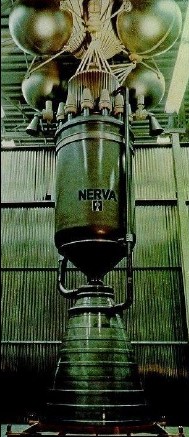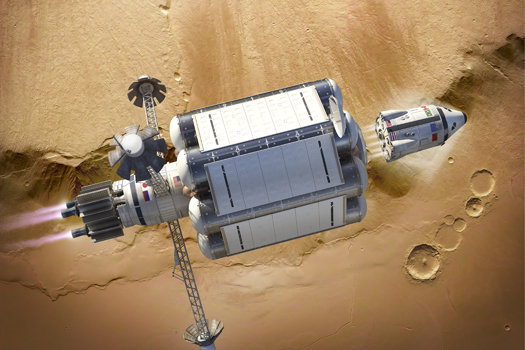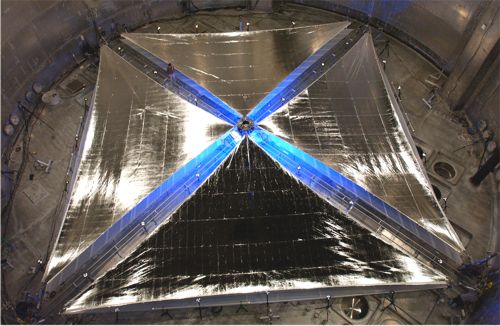In our last blog on space we looked at alternate methods of getting off the ground into low-Earth orbit. The goal is to lift larger and larger payloads into space so that humans can construct the engines that will allow them to explore the rest of the Solar System and even go beyond to the nearest neighbouring systems. Will we achieve this in the 21st century? It is not outside the realm of possibility when you consider that at the beginning of the 20th we had yet to achieve powered flight and were just getting into the age of the automobile.
How will we manage it? There are a number of technologies already developed or in the developing stages that we can use and enhance to help us get farther than we are today. Some of these technologies are suitable for human space flight while others would better serve us in robotic or pay load specific missions.
Ion Propulsion Engines
Ion propulsion has been used for two robotic space missions to visit asteroids – Hayabusa and Dawn. These engines work by taking a very small amount of gas and accelerating it to very high speeds. Chemical rockets do the reverse, taking large amounts of gas and spewing it out at slow speeds.
Ion propulsion systems are very economical in their use of fuel as opposed to chemical rockets which use fuel rapidly. Ion propulsion engines require a continuous electrical charge to operate and can run on fumes. That’s why missions like Hayabusa and Dawn deployed very large solar arrays to provide the necessary power to not just run on board equipment but keep the engines pushing the spacecraft forward.
Ion propulsion, however, is not a suitable technology for human space flight. In providing very little thrust constantly by shooting gas molecules out the back of the rocket motor at high speed it slowly gains speed over time. For the Dawn mission to Vesta and Ceres its ion propulsion system added incremental velocity once it had escaped Earth’s gravity at a rate of approximately 800 kilometers (500 miles) per hour per month of operation. That type of thrust is equivalent to pushing the spacecraft forward by pushing out a couple of drops of water. For a robotic mission slow and steady while conserving fuel may make a lot of sense. But you wouldn’t want to subject a human expedition to other planets with this technology.
Solar Sails
So ion propulsion is not a suitable choice. What about solar sails? This is another in-space propulsion technology. It requires no fuel other than getting the material that constitutes the sail into low-Earth orbit. Once there the sail unfurls and as photons from sunlight strike its reflective material, the sail slowly begins to provide thrust. Solar sails are lightweight, super-thin and massive in size. Japan deployed a solar sail on its Venus interplanetary mission named IKAROS in 2010. NASA has also deployed a sail, the NanoSail-D, a spacecraft that unfurled its gleaming sheet of space-age fabric 650 km above Earth in early 2011.

Solar sails like ion propulsion are not technologies designed to get from Point A to B in the shortest period of time. They are suitable for unmanned missions where time plays less of a factor. A good use of a solar sail would be an unmanned payload mission to deliver a large amount of materials into orbit around Mars. Such a voyage could take many years and could be launched well ahead of a manned mission that would follow and then utilize the material deployed by the solar-sail driven spacecraft.
Nuclear Thermal Engines
We have been using RTG (Radioisotope Thermal Generators) in space on missions to the outer planets for many years. RTGs use the heat from radioactive decay of plutonium fuel to provide energy and warmth to robotic spacecraft deployed in deep space. We deploy RTGs as a substitute for solar photovoltaics in missions where solar arrays cannot gather sufficient energy from sunlight. But the energy we derive from RTGs is not meant to be a propulsive force.
A nuclear thermal engine (NTE) on the other hand is intended to be used as a rocket providing the kind of thrust we obtain from chemical rockets. NTEs use an on board thermonuclear reactor to heat a fuel like liquid hydrogen. The fuel circulates around the core of the reactor in the same way water is heated in nuclear power stations on Earth to create steam that drives turbines. Substitute an engine nozzle for a turbine and you have a rocket with multiple NTEs capable of delivering thousands to millions of pounds of thrust.
Early NTE experiments by the Soviet Union used ammonia and alcohol as the propellant. But the United States developed a prototype called NERVA, that used liquid hydrogen. The choice of this fuel seems appropriate since the American space program in the 1960s became proficient in the use of hydrogen and today have built significant expertise in its usage for space flight.

NTE has advantages over chemical rockets. You only need to carry the hydrogen on board. You don’t need any oxidizer to create ignition. You can even consider adding hydrogen fuel to your tanks while en-route to your space destination using a giant cow-catcher to capture hydrogen atoms in space. That means you can go a lot farther and faster than with any of the technologies previously described. NTE technology has another benefit over chemical rockets. It is less complex, requiring fewer working parts so there is less chance of a mechanical failure.
The biggest drawback is radioactivity. NTE technology uses uranium for the reactor core. Although the technology is shut off until it reaches Earth orbit there is the potential for an accident during the launch phase. To counter the potential of atmospheric radioactivity in the event of such an accident, scientists propose encasing the uranium in tungsten. Tungsten has a high heat resistance and would keep the reactor core intact to minimize radioactivity escaping into the atmosphere.
NTE technology remains shut off until deployed in Earth orbit and the radioactivity generated gets dispersed into outer space once the engine is operational. Would a human crew be at risk of exposure? With proper shielding an NTE poses much less of a threat in space flight than does exposure to natural radiation from cosmic rays.
But NTE technology may be supplanted by another – the plasma engine.
Plasma Engines
From NERVA to VASIMIR, NASA’s Advanced Space Propulsion Laboratory is experimenting with a technology that could send a human crew to Mars and back in around four months compared to current chemical rockets which would take 10 months. Working with a company, Ad Astra, the developer of the technology, NASA would like to build 10 to 200-megawatt engines using this technology for human, robotic and payload missions to deep space.
What does VASIMIR stand for? Variable Specific Impulse Magneto-plasma Rocket, an idea that was first proposed in 1973 by Dr. Franklin Chang Diaz, an MIT graduate who happens to also be a NASA astronaut.
Like ion propulsion engines VASIMIR can only operate in the vacuum of space with a low thrust to weight ratio. But unlike ion propulsion, the VASIMIR can achieve much greater thrust and power while using very little fuel.
Launched into space using conventional chemical rockets or by other launch technologies such as we described in our last blog, VASIMIR would be payload until deployed in orbit.
How does VASIMIR work? It uses a pair of radio wave emitters surrounded by magnets to turn cold hydrogen, argon, and xenon gases into superheated plasma. The first radio wave emitter heats the gas to a cold plasma state, about equal to the surface temperature of the Sun (6,000 Celsius or approximately 9,900 Fahrenheit degrees). The second emitter drives the temperature higher to levels equal to those at the Sun’s core (1,000,000 Celsius or 1,800,000 Fahrenheit degrees). The magnets generate a shaped series of fields that contain the superheated plasma directing it backward to vent out through nozzles creating forward thrust. The use of magnetic field containment means no physical points of contact and longer engine life.
Providing power to the radio wave emitters and creating the magnetic fields requires a lot of electricity. That’s why these engines are described in megawatt terms. For example a near-Earth robotic missions could be powered by solar array capable of generating 2 Megawatts. But for larger missions like the one proposed to Mars, the engine would require on board nuclear reactors capable of generating much more power. Building and launching nuclear reactors into low-Earth orbit capable of generating 200 Megawatts is a significant task and not one without risk. This may prove to be the biggest impediment to deploying VASIMIR for human interplanetary flight.

A small 200-kilowatt VASIMIR prototype will be deployed and tested on the International Space Station in 2013.
In our next blog on this subject will look at the technology that science fiction has described – antimatter and Warp drives. Are they for real or will they always be fantasy?









